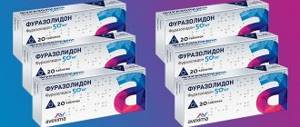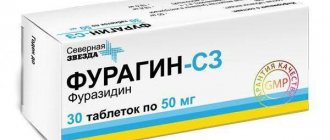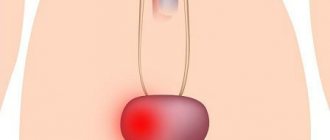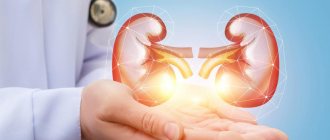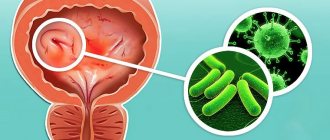In the article we will look at the instructions for use of “Palin” for cystitis and reviews.
The appearance of symptoms of cystitis immediately confronts patients with the choice of drugs that they should use in the treatment of this pathology. As a rule, in most situations the choice falls on one or another antibacterial agent. And this is not at all accidental, because it is with the help of antibiotics that the disease can be stopped. The remedy “Palin” for cystitis, according to reviews, is one of the most effective medicines that allows you to quickly get rid of inflammatory processes in the bladder.
Efficiency
"Palin" is a drug from the category of antibiotics belonging to the quinolone series. The main active ingredient of this medication is pipemidic acid. The drug is endowed, depending on the concentration, with bacteriostatic (it inhibits the proliferation of bacteria) or bactericidal properties (destructive for pathogens). Lower dosages of Palina act in a bacteriostatic manner, and high volumes provide bactericidal effectiveness. This drug can also effectively act on gram-negative bacteria such as Proteus, Escherichia coli, Enterobacteriaceae, Citrobacteriaceae, etc. It is considered moderately active against Providence, Klebsiella and Acinetobacter.
What else does the instructions for use of the Palin tablets for cystitis tell us?
The product, as a rule, has no effect on chlamydia, Pseudomonas aeruginosa, mycobacteria, anaerobic microscopic organisms (these are those that develop without receiving oxygen) and gram-positive flora. It is worth noting that resistance of organisms to the drug usually develops slowly. This medication is very well absorbed from the digestive system, reaching maximum concentrations in the bloodstream after one to two hours. High levels of the drug are observed in the kidneys, as well as in the prostate gland.
This medication binds to blood plasma proteins by no more than thirty percent. It is excreted from the human body with urine, and also through the intestines with bile. In twenty-four hours, from fifty to eighty-five percent of the received dosage of the drug is eliminated. This drug can pass through the placenta and in small quantities into breast milk. The medicine for cystitis “Palin” is used mainly for the treatment of urological and sometimes gynecological diseases.
Drug price
The drug can be purchased at any pharmacy. When purchasing Palin, the price of the medicine depends on the form of release, region, and pharmacy chain. The price range ranges from 224 to 350 rubles.
Palin for cystitis is an effective remedy that in a short time allows you to relieve the patient from the manifestations of cystitis, as well as eliminate the source of the disease itself. Before starting treatment, you must ensure that there are no contraindications, and also carefully study the instructions. In addition, remember that the presented remedy is not used in pediatrics.
The antibacterial drug Palin is widely used by doctors to treat urological and gynecological inflammations of a bacterial nature.
The active substance of Palin is pipemidic acid, which has a bactericidal (kills bacteria) and bacteriostatic (prevents the proliferation of microorganisms) effect. A bactericidal effect can be achieved by treating with large doses of the drug; when small and medium doses are prescribed, only a bacteriostatic effect is observed.
Release forms: capsules, suppositories and tablets
The product is released in several formats:
- There is a convenient form in tablets (one pill contains 400 milligrams of the active ingredient). They are packaged in twenty pieces in one blister.
- In addition to tablets, this medicine can be purchased in capsule form. One capsule contains 200 milligrams of the main ingredient. They are also packaged in ten pieces in cell packaging.
- Another form is suppositories. For example, one vaginal suppository contains 200 milligrams of the main component. This type of medicine is applicable for the treatment of pathologies in women. One package of medicine contains ten suppositories.
Contraindications
It is worth mentioning some contraindications to taking this drug:
- The presence of individual intolerance in the patient to any ingredient of this medicinal product.
- The occurrence of epilepsy along with diseases of the central nervous system with the presence of convulsive syndrome.
- Development of kidney failure against the background of creatinine clearance less than 10 milliliters per minute.
- The occurrence of liver failure against the background of chronic active hepatitis, cirrhosis, etc.
- The development of porphyria, which is a hereditary disease that disrupts the process of hemoglobin synthesis.
- The onset of pregnancy or breastfeeding.
- The patient's age is up to fourteen years and the period when the person is over seventy.
- The appearance of hypersensitivity to aspirin, and also to acetylsalicylic acid.
- The occurrence of hypersensitivity to other drugs related to the quinolone series.
With great caution, the drug in question should be prescribed to patients who have previously suffered a disorder in the cerebral circulation. In this case we are talking about hemorrhagic or ischemic stroke.
How to take the drug?
It is important to take palin, which is taken in the form of tablets and capsules, with plenty of water. It is important to increase the amount of fluid in general, drinking it between meals. The dosage of the drug is determined by the doctor depending on the course of the disease and the characteristics of the patient. Usually the medicine is divided into 2 doses - morning and evening. On average, Palin is taken for cystitis for about 10 days. Recovery may occur earlier, it all depends on the characteristics of the disease.
For chronic complicated inflammation, antibiotic use can be extended up to six months. Patients with impaired renal and liver function need to adjust the dose.
If the pathology of the kidneys and liver is moderate, then the drug can be taken in a standard dosage.
During pregnancy, treatment with this drug is not recommended, since its effect on the fetus has not been sufficiently studied. During breastfeeding, Palin can be used only if feeding is interrupted for the period of treatment.
This remedy should not be used to treat children under 14 years of age, since pipemidic acid accumulates in cartilage tissue, which harms the musculoskeletal system.
The drug should not be used by patients with cerebral circulatory disorders.
It is not recommended to prescribe this medicine to people over 70 years of age.
It is important to drink plenty of fluids while using Palin. The drug may cause photosensitivity, so it is better to avoid direct sunlight during therapy.
A long course of treatment requires constant monitoring of blood, liver and kidney functions, and general well-being.
In general, both doctors and patients speak positively about the drug. It is highly effective in combating pathogenic microflora and in most cases quickly eliminates inflammation.
Side effects
According to reviews of “Palina” for cystitis, in the process of using this drug, patients cannot do without the occurrence of some side effects. Moreover, each case may manifest its own pathological reactions. So, from the digestive organs the following is possible:
- The appearance of abdominal pain along with diarrhea, nausea, vomiting, heartburn and decreased appetite or its complete absence.
- The occurrence of increased gas formation in the intestines.
- It is worth noting that in rare examples, pseudomembranous colitis, which is an inflammation of the intestine caused by anaerobic microorganisms, cannot be ruled out.
The following side effects may occur on the functioning of the nervous system:
- In extremely rare cases, seizures occur.
- It is equally rare to expect headaches to appear in combination with visual disturbances, depression, agitation, hallucinations, confusion, body tremors, sleep disturbances, and the like.
In terms of the functioning of the hematopoietic and blood organs, the following is usually observed:
- Very rarely, a decrease in the number of eosinophils, which are a type of white blood cell, is noted.
- In elderly patients and in cases of impaired renal function, a decrease in the number of platelets, that is, platelets of blood that are involved in blood clotting, may be recorded.
- Patients with a congenital deficiency of the enzyme phosphate dehydrogenase may experience hemolytic anemia, which is anemia due to the destruction of red blood cells.
Among other things, allergic manifestations include urticaria along with skin itching, anaphylactic shock (a severe immediate reaction with rapid loss of consciousness). In addition, Johnson's syndrome, which is a very severe reaction with damage to the skin and mucous membranes, cannot be ruled out.
Other effects that cannot be excluded include the patient’s increased sensitivity to solar radiation, that is, photosensitivity, along with the development of resistance of pathogens to the described drug. It is also possible that a superinfection may occur when there is a layering of pathology with other pathogens.
Treatment with this remedy
How to take "Palin" for cystitis? This tablet must be swallowed and should not be chewed. Take the medication with water (at least one glass). During therapy, the patient should consume at least two liters of fluid per day, controlling the amount of urine. During treatment with Palin, it is recommended to avoid exposure to direct sunlight and ultraviolet radiation. During long-term therapy with the drug, it is necessary to monitor a general blood count along with liver and kidney functions.
Dosing the medication
Typically, the drug "Palin" is prescribed 200 milligrams twice a day with an interval of twelve hours. In some situations, for example, against the background of staphylococcal infections, the medication is prescribed in larger quantities, namely 200 milligrams three times every eight hours. The duration of the treatment course is determined by the doctor individually. The average course of therapy is ten days; if necessary, therapy is extended to six to eight weeks. For patients suffering from severe renal impairment, the dosage of this drug is adjusted. Women can be prescribed one vaginal suppository along with the pills once a day at night for seven to ten days.
special instructions
During treatment, it is recommended to take into account some features of the drug. This will help increase its effectiveness and reduce the likelihood of unwanted reactions.
The official instructions for use contain the following instructions:
- patients with severe renal impairment require dosage adjustment,
- with normal creatinine clearance, it is recommended to drink plenty of fluids and monitor the level of urine excreted,
- treatment of elderly people (over 70 years of age) is carried out with caution, since in this group of patients side effects are more pronounced,
- pipemidic acid has a photosensitizing property, so during treatment you should avoid direct sunlight on the skin and avoid sources of artificial ultraviolet radiation (for example, a solarium),
- uncontrolled use of antibiotics leads to the development of superinfections and reduced effectiveness of therapy,
- When driving a car or performing other activities that require increased attention, you must be careful.
Interaction with various medications
When taking Palina for cystitis for women, the following interactions should be taken into account:
- Antacids (which are drugs that reduce the acidity of juice in the stomach) and sucralfate can reduce the absorption of the drug in the digestive system. In cases where their combined use is necessary, it is imperative to observe intervals between the use of drugs of two to three hours.
- With prolonged use together with caffeine and Theophylline, this medication can help increase the concentration of these drugs in the blood.
- The drug "Palin" can lead to an increase in the effects of treatment with "Rifampin", "Warfarin", non-specific anti-inflammatory drugs and "Cimetidine".
- As part of the joint administration of “Palina” with antibiotics from the aminoglycoside category, an increased bactericidal effect on microorganisms is noted.
- The simultaneous administration of Palina with other drugs from the quinolone category and with non-narcotic painkillers increases the risk of seizures.
Palin
Palin is an original medicine that is used to treat urological (in rare cases gynecological) infections. The antibiotic can be used in both men and women; in children - only from 14 years of age.
The active component of the drug is pipemidic acid, which belongs to the quinolone series. The action of this drug is based on its ability to inhibit the enzyme responsible for bacterial DNA replication.
Palin is most often prescribed for cystitis, as well as for the treatment and prevention of other diseases of the urinary tract and bladder caused by microorganisms sensitive to it. The drug is also used in the complex treatment of vaginal infections and prostatitis.
Clinical and pharmacological group
Antibacterial agent from the quinolone group, urological antiseptic.
Prices
How much does Palin cost in pharmacies? The average price in 2020 is 280 rubles.
Release form and composition
Dosage form - capsules: size No. 1, opaque, body - white or white-yellowish, cap - green; contents – hygroscopic powder of white or white-yellowish color (10 pieces in blisters, 2 blisters in a cardboard box).
Active ingredient: pipemidic acid trihydrate, 1 capsule – 235.6 mg, which corresponds to 200 mg pipemidic acid.
Auxiliary components: colloidal silicon dioxide, magnesium stearate, corn starch.
Capsule composition:
- Body: titanium dioxide (E171), gelatin and sunset yellow dye (E110);
- Cap: titanium dioxide (E171), gelatin, brilliant black dye (E151), patent blue dye (E131), sunset yellow dye (E110), quinoline yellow dye (E104).
Pharmacological effect
The preparation of a number of quinolones has a pronounced bactericidal effect. Pipemidic acid not only suppresses the activity of Escherichia coli, Staphylococcus aureus, Enterobacter, Klebsiella, and other microorganisms, but also destroys the cell wall of bacteria, which leads to the death of infectious agents.
The bioavailability of uroseptic components is from 30 to 60%. The maximum concentration of the active substance was observed after 1 hour 20 minutes. Pipemidic acid is found unchanged in urine, secretions, and kidneys. The lack of metabolism allows the active substance to fight harmful bacteria throughout the urinary tract.
Pipemidic acid appears in small quantities in breast milk. The half-life of the active substance in urine is 2 hours.
Indications for use
Palin, according to the instructions, is prescribed for the treatment of acute and chronic infectious and inflammatory diseases of the urinary tract caused by microorganisms sensitive to the active substance, namely:
- Pyelonephritis;
- Cystitis;
- Urethritis;
- Prostatitis.
The drug is also effective for the prevention of infections during instrumental interventions in gynecological and urological practice.
Contraindications
The drug requires caution in case of cerebrovascular accidents. High-risk groups include people with epilepsy and people over 70 years of age. Palin is not recommended for use under 14 years of age.
The medicine should also not be taken by patients who have:
- Diseases of the central nervous system;
- Porphyria;
- Impaired kidney and liver function;
- Cirrhosis of the liver;
- High sensitivity to components.
During treatment, driving and other activities that require increased attention or pose a danger to the environment are prohibited.
Use during pregnancy and lactation
There are no studies confirming the safety of using Palin during pregnancy. Therefore, Palin is not prescribed to pregnant women.
Since Palin passes into breast milk, breastfeeding should be stopped during treatment with this drug.
Dosage and method of administration
The instructions for use indicate that Palin is indicated for oral use before meals.
Usually prescribed 200 mg (1 capsule) 2 times a day at 12-hour intervals (morning and evening). The duration of treatment is determined individually. For kidney diseases, it usually takes from 3 to 6 weeks, for prostatitis – 6-8 weeks.
For staphylococcal infections, the daily dose is increased to 600 mg - 1 capsule 3 times a day at intervals of 8 hours. The average duration of therapy is 10 days; if necessary, the course is increased.
How to take Palin for cystitis
Palin is used for cystitis as a reserve drug, when for justified reasons the prescription of other antibiotics is not possible:
- acute uncomplicated cystitis – 400 mg (2 capsules) twice a day for 10 days;
- chronic cystitis – 400 mg twice a day for 2 to 4 weeks;
- prevention of repeated exacerbations - 200 mg 2 times a day for up to 30 days (in some cases, longer use of the drug is possible - up to 6 months) or 200 mg 2 times a day monthly for at least 3 months - 10-14 days.
Side effects
The use of the drug may cause the following side effects:
- Digestive system: attacks of nausea, vomiting, gastralgia, diarrhea, pain in the epigastric region; in rare cases, severe diarrhea with pseudomembranous colitis.
- Central and peripheral nervous system: in rare cases - headache, dizziness, hallucinations, confusion, depression, agitation, sensory disturbances, visual disturbances, convulsions, tremor, sleep disorders; extremely rarely – grand mal seizures.
- Allergic manifestations: skin rashes, urticaria, mild itching, eczema, Stevens-Johnson syndrome; very rarely - anaphylactic reactions. All these reactions are reversible.
- Hematopoietic system: in patients with glucose-6-phosphate dehydrogenase deficiency, there is a risk of hemolytic anemia; in elderly patients and in patients with functional renal impairment, thrombocytopenia may develop; There are isolated reports of the development of eosinophilia.
- Other: superinfection, development of resistance, photosensitivity.
Overdose
It is prohibited to exceed the one-time or daily norm, or to extend the course of antibacterial therapy without the doctor’s permission. Excessive accumulation of pipemidic acid can cause negative reactions.
In rare cases, negative manifestations occur:
- vomit;
- dizziness;
- nausea;
- convulsions.
To eliminate negative signs, gastric lavage and sorbent intake are prescribed. Diazepam is recommended to eliminate seizures.
special instructions
Before you start using the drug, read the special instructions:
- Cannot be mixed with alcohol.
- During the period of use of the drug, the patient should drink plenty of fluids.
- When using the drug, it is recommended to refrain from driving.
- Due to the possible development of photosensitivity, during the period of use of the drug it is necessary to avoid contact with ultraviolet rays on the skin.
- This medicine should not be used in children. Pipemidic acid can accumulate in cartilage tissue.
- The drug is used with caution in patients who have in the past suffered circulatory disorders in the brain (including hemorrhagic stroke), seizures, even epilepsy.
- For people over 70 years of age, the drug is used with extreme caution, since at this age the likelihood of developing side effects increases significantly.
- The use of the drug for children is not recommended, as it can accumulate in cartilage and bone tissue and affect their growth process.
Drug interactions
When using the drug, it is necessary to take into account interactions with other medications:
- Palin can lead to an increased effect of Rifampicin, Warfarin, nonspecific anti-inflammatory drugs, Cimetidine.
- With long-term use together with Theophylline and Caffeine, Palin can help increase the concentration of these drugs in the blood.
- Antacids (drugs that reduce gastric acidity) and sucralfate can reduce the absorption of Palin in the digestive tract. If it is necessary to use them together, it is necessary to maintain an interval of 2-3 hours between taking the drugs.
- When Palin is prescribed simultaneously with other drugs from the quinolone series and with non-narcotic painkillers, the risk of seizures increases.
- When Palin is prescribed together with antibiotics from the group of aminoglycosides, an increased bactericidal effect on bacteria is observed.
Reviews
We have selected some reviews from people who have used the drug Palin:
- Alexandra. Pyelonephritis and cystitis are pressing problems for many women, and for me too. When discomfort begins, I immediately take Palin, one capsule at a time every 12 hours. The more water I drink, the fewer side effects I have, I understand this from numerous reviews. No medicine helped me as quickly as Palin, regardless of the price.
- Veronica. Cystitis has haunted me since adolescence. I never treat myself, I always go to the doctor. Twice he prescribed Palin to me in capsules. The drug helps quickly, but after using it it takes a long time to restore bowel function, because the drug causes severe upset. I can’t keep silent about this in my review.
- Pauline. A good antibacterial drug. It eased my suffering and discomfort from cystitis: there were pains when urinating, when I went to the toilet, and there was also pain in the lower abdomen near the bladder. Such an unpleasant disease(((I caught a cold at sea. We met the dawn on the wet and cold sand. Of course, there is still romance, but the consequences in the form of cystitis are not even romantic at all). Not only do you always want to go to the toilet little by little, but it also hurts every time((I took one tablet of Palin 2 times a day. It helped me!
Analogs
Structural analogues of the active substance:
- Vero Pipemidine;
- Pimidel;
- Pipegal;
- Pipelin;
- Pipem;
- Uropimide;
- Urotractin.
Before using analogues, consult your doctor.
Storage conditions and shelf life
The shelf life of Palin capsules is 5 years from the date of their manufacture. The drug should be stored in its original original packaging, in a dark, dry place, out of reach of children, at an air temperature not exceeding +25° C.
Source: https://simptomy-lechenie.net/palin/
Composition Palin
The active substance is pipemidic acid.
Manufacturers
Akrikhin KhFK (Russia), Lek d.d. (Slovenia), Lek dd., packaged by Sotex PharmFirm (Slovenia)
pharmachologic effect
Pharmacological action – antibacterial (bactericidal).
Active against most gram-negative (pseudomonas and Escherichia coli, Proteus, Klebsiella, Shigella, Salmonella, etc.) and some gram-positive microorganisms (St.aureus).
Rapidly absorbed, bioavailability is 30-50%.
The maximum concentration is achieved 70-80 minutes after oral administration at a dose of 400 mg.
High concentrations are created in the kidneys and prostate gland.
Passes through the fetoplacental barrier and enters breast milk in trace amounts.
The half-life is 2 hours 15 minutes; in case of renal impairment, the half-life is 16 hours.
In case of severe renal impairment, therapeutic concentrations are also created.
It is excreted mainly unchanged by the kidneys.
Side effects Palin
Nausea, stomach pain, photosensitivity, allergic skin reactions, headache, dizziness, blurred vision, weakness, hemolytic anemia, muscle weakness, myalgia.
Very rarely - depressive disorders, hallucinations, psychosis, grand mal seizures.
Contraindications Palin
Hypersensitivity, severe renal and liver dysfunction, I and III trimesters of pregnancy, childhood.
Restrictions on use:
- Caution should be exercised in case of renal failure.
Children taking the drug should be under close medical supervision.
Directions for use and dosage
Orally – 400 mg (no more than 600 mg) 2 times a day; course – 10 or more days.
For urinary tract infections, women, along with tablets (capsules), are prescribed 1 vaginal suppository at night for 7-10 days.
Interaction
The activity is enhanced by drugs that alkalize urine.
Inhibits cytochrome P450, inhibits metabolism and increases the likelihood of side effects of theophylline and caffeine.
Storage conditions
Store at room temperature in a cool, dry place, away from children.
Leave procedure
Dispensed by prescription.
Source: https://Elixir.farm/lekarstva/palin/
During pregnancy
To date, there are no studies that would confirm the safety of using Palin during pregnancy. In this regard, this medication is not prescribed to pregnant women. Given that it passes into breast milk, they should stop breastfeeding the baby during therapy.
We will consider reviews of “Palina” for cystitis in women in more detail.
Symptoms and treatment of cystitis in women at home
Cystitis is a very dangerous disease that can lead to serious complications. It needs to be treated from the first days. How you can quickly and effectively get rid of cystitis in women, we will talk about symptoms and treatment at home in our article.
If you notice the first symptoms of this disease in time and do not let the disease take its course, it can be completely cured at home, observing bed rest and adhering to the prescribed course of treatment.
Symptoms of bladder inflammation in women
The main symptoms of cystitis, which indicate that it is necessary to urgently begin treatment:
- Acute pain and burning when urinating.
- Difficulty urinating with constant urge.
- Traces of blood in the urine.
Cystitis has 3 forms:
Acute - occurs a couple of hours after hypothermia or other circumstances accompanying inflammation. Accompanied by severe pain and discomfort.
Recurrent – is a consequence of improper self-medication, when the disease flares up with renewed vigor every 2-3 weeks. May indicate other diseases of the genitourinary system.
Chronic – signs of cystitis accompany the patient constantly, periodically dulling with medications.
Reasons for the development of cystitis in women
The most common cause of inflammation in cystitis in women is an infection that develops in the bladder with the penetration of microorganisms and bacteria into it.
These are E. coli, as well as other bacteria that inhabit the microflora of the intestines and vagina in women. That is, a common cause of the disease is self-infection, when the pathogen enters the urethra from the colon or vagina.
However, the disease can not only begin from the outside, but also from the inside - through the kidneys. Then we are talking about the fact that cystitis is a kind of side effect of another disease.
It is worth noting that microorganisms from the vagina and colon enter the bladder every day due to the anatomical features of the structure of the female body. But cystitis does not start in all girls and women. Why. Because for the development of the inflammatory process, the presence of certain favorable factors is necessary that reduce the body’s resistance to infections.
Here are the main factors:
- Hypothermia, as a result of which blood circulation in the bladder mucosa slows down, making it vulnerable to pathogens.
- Injuries to the vaginal mucosa during defloration, childbirth and sexual intercourse, which create a favorable environment for the development of infection.
- Age and hormonal imbalances. Little girls, older women and patients with hormonal problems have low resistance to infection.
- Pregnancy, when the body's defenses are weakened. In this case, the uterus in an enlarged state can cause stagnation of urine in the bladder.
These are the factors that influence the development of cystitis in women. Symptoms and treatment at home, quickly and without complications, depend on the pathogen. Diagnostics can determine what caused the disease.
Diagnosis of the disease
Before we tell you how to treat cystitis in women, let's talk about diagnosis. It involves mandatory blood and urine tests that will help determine the cause of the disease - the causative agent of the infection.
Based on the test results, your doctor will be able to prescribe a course of antibiotics and other medications to treat your bladder.
If there is a possibility that cystitis is a consequence of another disease, the patient is prescribed an ultrasound, x-ray or CT scan.
Treatment of the disease
Treatment of cystitis in women can only be prescribed by the attending physician after diagnosis. If we are not talking about advanced forms of acute cystitis and the patient seeks help in a timely manner, this disease can be treated at home with bed rest.
Do you want to know what to do if you have cystitis? See a doctor! After all, treatment consists of a course of medications, and may also include traditional medicine and home methods. They play a supporting role and help relieve cystitis.
Properly prescribed treatment at home, using tablets and traditional medicine, will quickly return you to your normal lifestyle within 5 days and help you forget about the unpleasant illness forever.
Treatment at home prohibits any physical activity, unprotected sexual intercourse, alcohol, caffeinated drinks, soda, as well as spicy, salty and fried foods.
A pregnant woman is treated only as prescribed by the attending physician. In this situation, most drugs that affect the inflammatory process (primarily antibiotics) can harm the fetus, especially in the first trimester of pregnancy.
Before treating cystitis while breastfeeding, it is necessary to undergo diagnostics and consult a doctor who will prescribe drugs that are safe for the child.
Drug treatment
Treatment of cystitis at home involves prescribing a course of the following groups of drugs:
- Antibacterial antimicrobial drugs. These are antibiotics that fight the cause of inflammation.
- Probiotics. These are medications that contain bifidobacteria to neutralize the aggressive effects of antibiotic therapy and develop normal microflora of the gastric mucosa and pelvic organs.
- Antispasmodic drugs that relieve pain.
- Herbal preparations with vitamins and mineral supplements.
Now we’ll tell you in more detail about how to treat cystitis at home quickly and effectively, talk about the characteristics of the effects of each of these groups, and also give examples of medications.
Antibiotics
We have already written about how important it is to conduct a diagnosis before prescribing a course of antibiotics. The fact is that certain antibiotics affect certain groups of bacteria and microorganisms. In addition, each of us has an individual susceptibility to antibiotics, which the doctor can only find out from the results of blood and urine tests.
There are many antibiotics that have cured millions of women from this disease. We will tell you about the most popular ones.
- Norfloxacin. As a rule, in most cases, cystitis can be quickly cured by taking a 5-day course of norfloxacin, which destroys microorganisms and is used in the treatment of many diseases of the genitourinary system. Indicated for chronic cystitis with prolongation of the course of treatment.
- Monural. A very strong drug that knows very well how to cure cystitis. It relieves acute inflammation in just one dose. This antibiotic is contraindicated in the treatment of chronic forms of the disease, since repeated use can have a negative effect on the body.
- Furagin. A frequently used antimicrobial drug to treat both adult women and little girls. How quickly can you get rid of the disease? The course of treatment ranges from 7 to 10 days, depending on the condition of the disease and the doctor’s instructions.
- Palin. Effective in treating the acute form if the causative agent of cystitis is bacteria.
Probiotics
Antibiotics during the inflammatory process destroy both harmful and beneficial bacteria necessary for the mucous membrane of the stomach, bladder, vagina and colon. To completely cure cystitis at home in women, probiotics are needed.
If you do not colonize the mucous membrane with the bacteria it needs, re-inflammation will not take long to occur, and you will also have to treat another disease: dysbiosis. Its main manifestations are: stomach pain, flatulence, belching, diarrhea, constipation and thrush.
To avoid these troubles, the patient is prescribed probiotics: tablets and suppositories. Tablets populate the microflora of the gastrointestinal tract with beneficial bacteria, and suppositories populate the vagina.
The most effective drugs for oral administration are Linex, Bifiform and yogurt norms, vaginal suppositories - Vagilak.
The course of taking probiotics is 7-10 days, but in no case can it be less than the course of taking antibiotics.
Antispasmodics
One of the very first and most unpleasant symptoms of cystitis is pain and burning when urinating. Antispasmodics will help relieve this symptom. How to relieve pain? The course of treatment involves taking the following medications:
No-shpa. A common drug that quickly relieves muscle spasms and dilates blood vessels.
Ibuprofen. A very strong pain reliever that relieves fever and inflammation. It is prescribed for advanced disease, when the patient, in addition to severe pain, has a rise in body temperature.
Because these drugs are powerful, they should be taken in the dosage prescribed by your doctor and should be stopped immediately after the fever and pain subside.
The effectiveness of the drug for cystitis
According to urologists, over the years of using Palin as part of urological practice, the sensitivity of microscopic organisms to the drug has changed, that is, they have developed resistance to it. Therefore, this medicine can be recommended for the treatment of uncomplicated forms of acute or chronic cystitis. The use of "Palin" is advisable as a reserve drug when for some reason the use of modern antibiotics is impossible, for example, when it is impossible to treat with "Monural", "Cifran", "Xenavin" and other drugs. In any situation, self-medication of cystitis is dangerous and harmful. Only a doctor can correctly select medications for treatment, dosage and duration of the therapeutic course.
Dosage
The dosage of Palin is determined based on the form of the pathology. If it does not have complications, or cystitis is acute, then the recommended daily dose is 400 mg, and the course of treatment lasts from a week to two.
For chronic cystitis, it is also necessary to take 400 mg of the drug per day, but the course of treatment is usually longer and can last up to four weeks.
To prevent cystitis, the medicine is taken for 10-14 days, 200 mg per day. In all cases, the indicated dosage should be divided into two doses.
This dosage and duration of treatment is recommended and should be adjusted by a doctor after examination and testing.
In the presence of pyelonephritis
Currently, this medication can be used to treat uncomplicated forms of pyelonephritis. It is advisable to carry out antibacterial treatment taking into account the sensitivity of bacterial pathogens isolated during bacteriological urinary culture. It is permissible to start treatment with Palin in the usual dosages in the first three days of pathology.
After three days of use, the results of therapy are assessed, paying attention to the improvement in general well-being, and in addition, urine analysis indicators. After three days, a bacteriological examination of the urine will be ready. If the pathogen is sensitive to this medication and there are positive changes in well-being, therapy is continued for up to three to six weeks. Repeated bacteriological urine cultures are periodically carried out along with testing the sensitivity of the pathogen.
In the instructions for use of “Palin” for cystitis, analogues are not indicated.
Reviews of "Palina" for cystitis
It is worth saying that among the reviews about this medication there are many positive as well as negative opinions. Some people note a pronounced therapeutic effect from this remedy at a relatively low cost. Such comments represent approximately forty-one percent of the total. But there are also many reviews from women about “Palina” for cystitis, which say there is no effect from its use.
The authors of these messages write that the low cost of the drug is consistent with its low quality. It is also important to note that many patients online encourage others to be treated with more modern medications. Many authors of reviews about “Palin” for cystitis admit that they are put off by the excessive number of adverse reactions, in connection with this people are forced to refuse its use and they have to look for analogues.
Reviews from doctors and patients
Reviews from doctors and patients will help you form a general opinion about the drug, as well as learn about its effectiveness and possible side effects.
Yaroslava, 23 years old
I encountered cystitis unexpectedly. Before that, everything was fine, but at night I woke up with an unbearable desire to go to the toilet. After trying to empty my bladder, which I failed, I felt pain and burning. Since I knew nothing about cystitis before, I ran to the gynecologist in the morning, and from there to the urologist. So I was diagnosed and prescribed Palin. These are small capsules in a gelatin shell. They should be swallowed whole and washed down with plenty of water. I was prescribed a course for 5 days, 2 tablets in the morning and evening. The symptoms disappeared the very next day after starting treatment. As for side effects, I did not feel them either during the course or after its completion. The product is very effective, I recommend having it in your first aid kit.
Cost of the medicine
So, as noted earlier, the cost of this remedy is not at all that high, so it is absolutely affordable for citizens. For example, for the tablet format you need to pay from eighty to one hundred rubles. As for capsules, they will cost the consumer from one hundred ninety to two hundred and thirty rubles per package.
In conclusion, it is worth saying that antibiotic therapy is usually carried out for ten days, but in more severe cases, Palin tablets for cystitis are prescribed for up to eight weeks. If the doctor recommended using this medication for a longer period of time, then patients should undergo periodic tests, as there have been cases where examples of the effect of this drug on blood counts have been noted.
We reviewed the instructions for use for “Palin” for cystitis and reviews of this medicine.
Advantages over analogues
Palin for cystitis and mild forms of pyelonephritis is prescribed after bacteriological culture, and after determining the type of pathogen, vaginal suppositories or tablets are prescribed.
Advantages of using Palin for cystitis:
- already after two doses of the medicine there is a sharp relief from the primary symptoms of the disease and a general improvement in well-being;
- positive reviews from patients and the experience of doctors have revealed a minimal possibility of repeated recurrence of cystitis;
- the drug rarely has side effects and negative reactions;
- in some cases, the drug can prevent some forms of urological surgery;
- the choice of available forms of the product allows you to drink Palin or use it in the form of candles;
- minimal load on the gastrointestinal tract;
- affordable price due to the production of the drug by domestic pharmaceutical companies.
